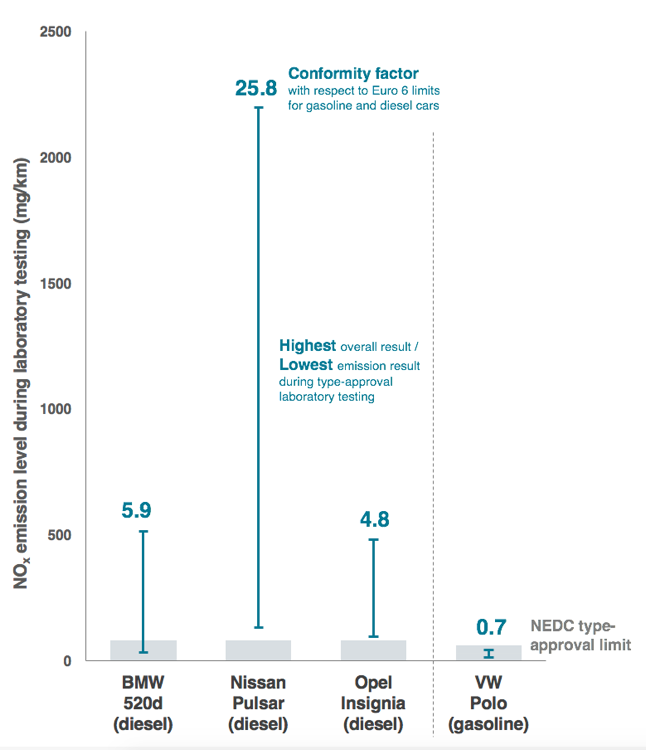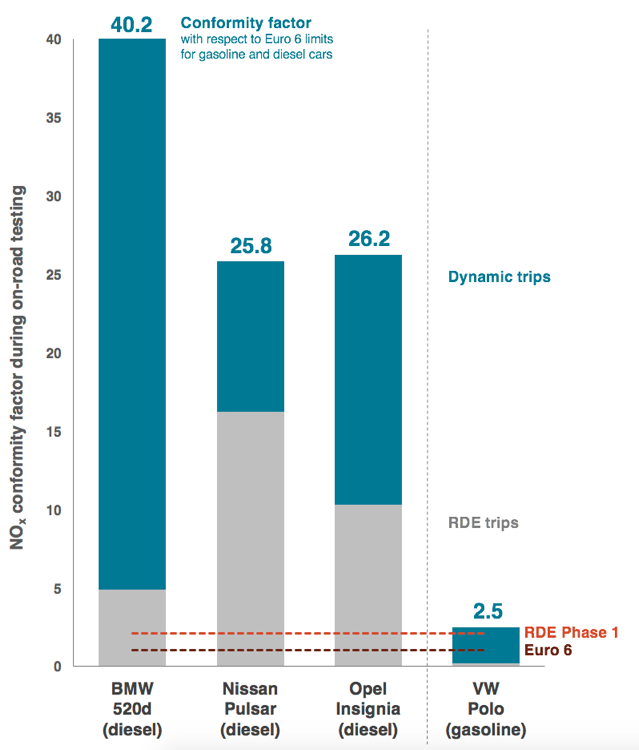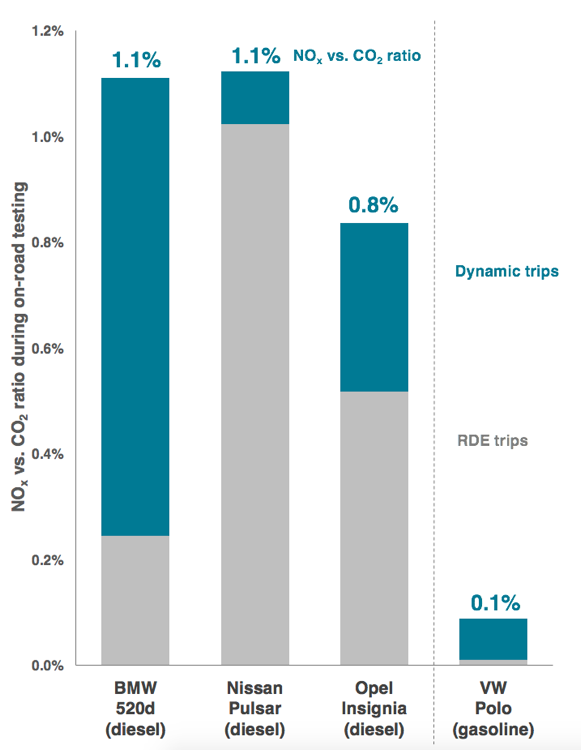Blog
Will the future RDE regulation be enough to restore trust in diesel technology?
The Volkswagen Group (including Audi and Porsche), Opel, Fiat, Renault, and now Daimler are recalling millions of diesel vehicles for a software update. All of these manufacturers claim their vehicles are meeting the emissions standard for nitrogen oxides (NOX). So why bother changing anything?
The updates are aimed at improving emissions in consumers’ real-life situations, because car manufacturers seem to recognize that two worlds exist today: One is the idyllic world of the type-approval test, where there is a defined protocol under laboratory conditions and where emissions usually comply with the regulatory limit. Then there is the real world, with much broader conditions and where emission levels can be much higher than what the official figures show. In the real world, emission levels impact climate change, air quality, and human health. The sudden efforts by some manufacturers to close the gap between these two worlds is not innocent; their main objective is to slow the decline of diesel in a last-ditch attempt to buy back its reputation and avoid a massive diesel ban across many cities.
For most diesel passenger cars in the European Union, these two distinct worlds became evident after a series of post-Dieselgate national testing campaigns. In a previous blog, I described a test campaign led by France that showed how stepping outside the exact conditions in the protocol defined by the European type-approval regulation—by reproducing the official test cycle (NEDC) on a road instead of in a laboratory—was enough to reveal a large difference in emissions (more than 5 times) compared with the regulatory limit for Euro 6 vehicles.
Beginning in September 2017, the real-driving emissions (RDE) test will complement the current laboratory certification procedure for what the regulation calls “new types” of vehicles (essentially a new model or an existing one that received a major modification), and for all vehicles by September 2019. The regulation will impose an on-road limit for NOX as measured under more realistic operating conditions, which should help bring down real-world emissions. But emissions under what the regulation defines as “less frequent” situations (which obviously depends on where and how is the car is driven) will remain unlimited for the first RDE phase, such as when the ambient temperature is below –2°C, when the altitude is higher than 1,300 m, or when the car is being driven in a way that is considered too dynamic (e.g., sportier driving on a hilly road). Given these limitations, we wondered: Will the RDE test sufficiently represent conditions in the real world? What proportion of the emissions will happen outside the test conditions—where no one is watching?
We commissioned the Laboratory of Applied Thermodynamics, of the Aristotle University of Thessaloniki, and its spin-off company, Emisia, to investigate some of these questions. Four Euro 6 passenger cars—one gasoline and three diesel vehicles with different aftertreatment technologies—were tested under variable conditions, both in the laboratory and on the road. The final report is detailed here.
Laboratory testing

The first tests aimed to reproduce the type-approval NEDC test cycle. For NOX emissions, Figure 1 shows that the BMW 520d (diesel) and the Volkswagen Polo (gasoline) vehicles had laboratory test results (the lower bar) that fell below the NEDC type-approval limit, meaning they passed the test. The Opel Insignia (diesel) and the Nissan Pulsar (diesel) vehicles failed it, at best exceeding the limit by 19% and 66%, respectively.
We also conducted a series of tests using different vehicle speed profiles, which included the ARTEMIS cycle, a test that is based on a large database of European driving patterns and is closer to real-world driving style than the NEDC. During these tests, NOX emissions from every diesel vehicle skyrocketed, as shown by the highest bar in Figure 1. The Nissan Pulsar scored the worst for NOX emissions on the urban version of the ARTEMIS cycle, nearly 26 times the Euro 6 limit for diesel vehicles. What’s worse is that the engine was already warmed up for this test, a theoretically favorable condition for achieving low NOX emissions (see this blog post on the hot restart pretext). By contrast, the Volkswagen Polo gasoline car showed consistently low emissions in the laboratory, regardless of the test, despite more stringent limits for gasoline vehicles compared to those for diesel.
On-road testing

To bring our testing another step closer to real-world conditions, we brought the vehicles on the road and performed two series of tests (Figure 2).
The first series of tests followed the RDE regulation protocol, which includes defined limits for dynamic driving style. Again in contrast to the Volkswagen Polo gasoline car, which produced results on the road that were consistent with the laboratory test, all three diesel vehicles emitted NOX at levels well above the future RDE conformity factor of 2.1 times the Euro standard: 5 times for the BMW 520d, 10 times for the Opel Insignia, and 16 times for the Nissan Pulsar.
Manufacturers will design RDE-compliant versions of these diesel vehicles. But will that be sufficient to cover most of the emissions encountered in real-world situations? For the second series of on-road tests, we looked beyond the RDE requirements and drove the vehicles more dynamically than the RDE test specification permits, but under conditions that do occur in real-life situations. This revealed another part of the story: all tested vehicles were sensitive to a “sportier” driving style. The Volkswagen Polo gasoline car slightly exceeded the RDE limit, but it had the lowest NOX emissions by far of all the other vehicles tested. The Nissan Pulsar and the Opel Insignia’s NOX emissions continued to grow substantially, with both emitting NOX at 26 times the laboratory type-approval limit.

The BMW 520d demonstrated peculiar behavior by scoring the best (relative to other diesel vehicles) under RDE-compliant conditions, and simultaneously the worst—with 40 times the Euro 6 limit—under non-RDE-compliant driving conditions. Why such a difference? One could argue simply that a more dynamic driving style requires more fuel, leading to the emission of more pollutants. But our analysis of the ratio between NOX and CO2 (the natural result of fuel combustion) suggests that the BMW 520d is much worse at avoiding NOX emissions in demanding driving conditions compared to RDE-compliant conditions (indicated by the blue bar in Figure 3). When driven to emulate the RDE-compliant test, the BMW 520d significantly outperforms the Nissan Pulsar in terms of NOX emitted per quantity of fuel used; when driven harder, it is just as bad. A deeper investigation also revealed a measurable discrepancy in the behavior of the lean NOX trap (LNT) aftertreatment system (i.e., how the emissions are treated once they leave the engine) in the BMW 520d, whose NOX purges were never triggered under more dynamic conditions. It is as if the vehicle had no NOX aftertreatment, similar to a Euro 5 generation vehicle at best.
But why do the vehicles’ emissions under more demanding conditions really matter if these conditions are less frequently experienced in real-world situations? Because the future type-approval regulation will not cover these situations, there will be limited incentives for manufacturers to reduce emissions under these and many other excluded conditions (based on temperature, altitude, traffic congestion, etc.), as detailed in a report from TNO. And the emissions from these situations could be significant. For example, dynamic exclusion is theoretically designed to cover 95% of cases. But if emissions outside the scope of the standard stay as high as measured in our testing, the remaining 5% of cases could still represent up to 50% of total emissions—a significant amount of real-world emissions that would remain undisclosed, seriously undermining the real benefits of these future regulations.
Policy implications
The upcoming RDE on-road test procedure is an important step toward lowering real-world emissions, but it will not bring down NOX emissions from diesel passenger cars in all circumstances. At this critical moment, manufacturers have an opportunity to win back customers’ trust in diesel technology, by showing that NOX emissions can be consistently low, even outside the prescribed rules. Our analysis shows that, in this regard, gasoline technology is clearly a step ahead of diesel technology; for diesel, there are few incentives for manufacturers to control NOX emissions outside of the current testing conditions. The success of the RDE regulation will depend on the will of manufacturers to prove that they have learned a lesson from Dieselgate by beginning to focus on reducing real-world emissions, not just on passing a particular test.
